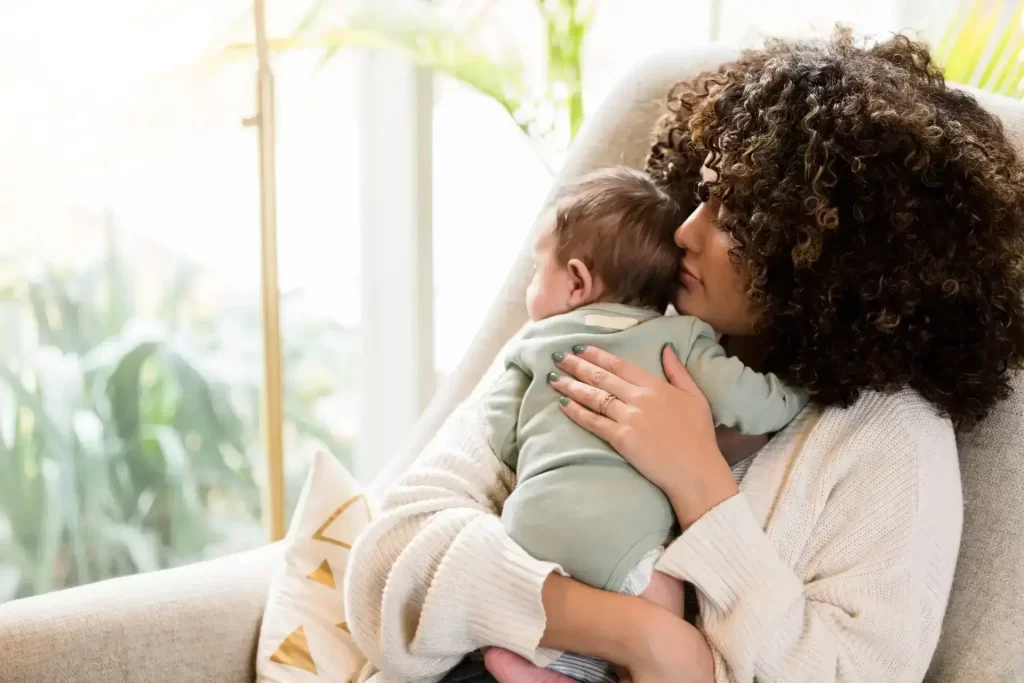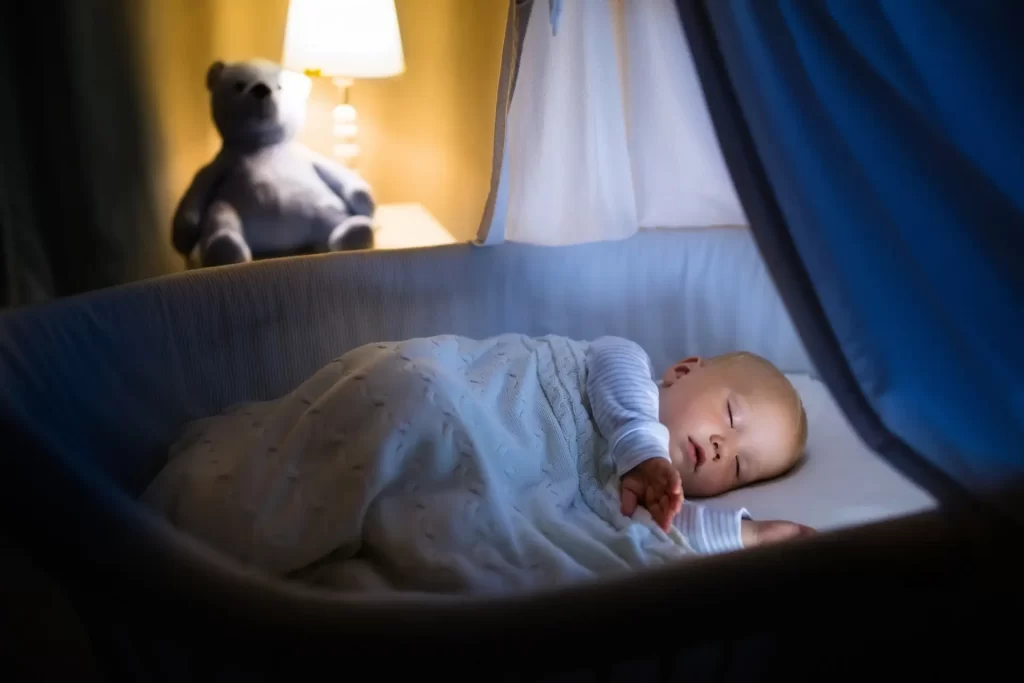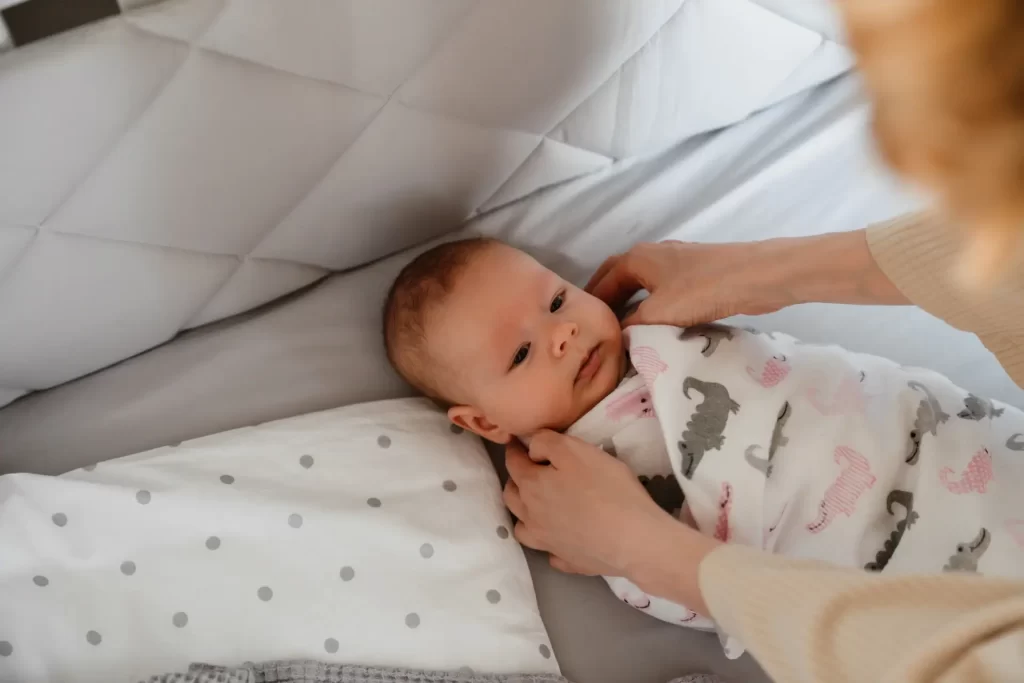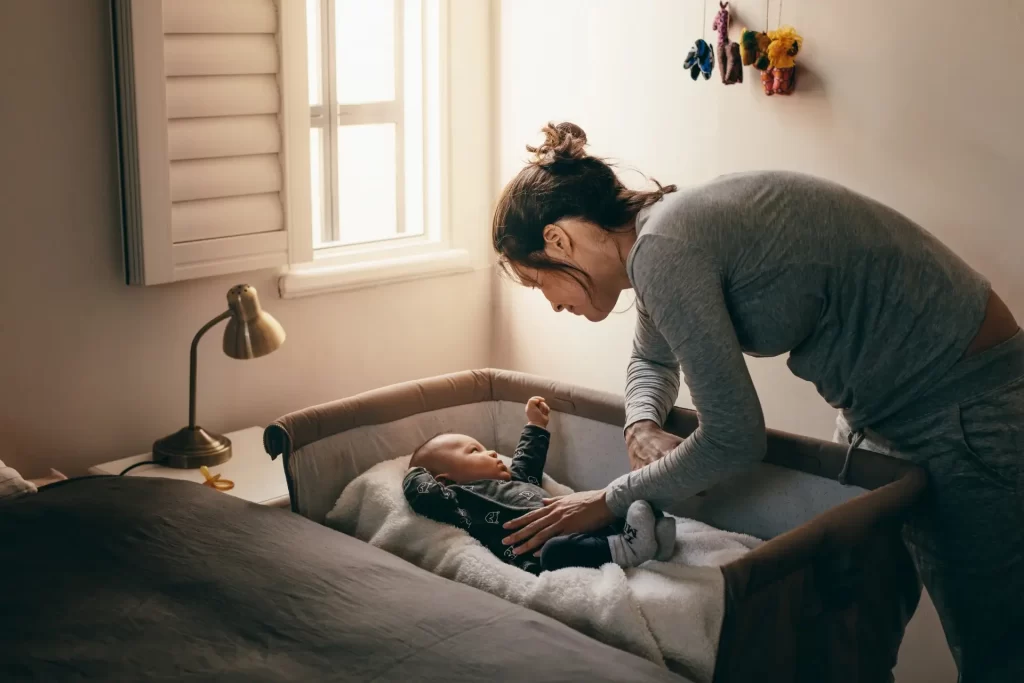Dad of 5. CEO & Co-Founder of Avocado Health. Former HealthTech & FinTech Founder. Passionate about empowering families and driving change in parenting and child development.

Table of Contents
Contact naps. The phrase itself evokes images of snuggling a tiny, warm body close, feeling their soft breath against your skin. It’s a practice as old as motherhood itself, a primal response to a baby’s innate need for closeness. But in our modern world, where sleep training and independent sleep are often emphasized, contact napping can become a source of both comfort and confusion.
Contact naps are a hot topic in the parenting world. We’ll cut through the confusion and explore the science, benefits, and practicalities of this common, yet often debated, parenting practice. We’ll also discuss how to keep contact naps safe by adhering to expert-recommended sleep guidelines.
What is a Contact Nap?
A contact nap occurs when a baby or toddler sleeps while physically touching their parent or caregiver. This can involve the baby sleeping on the parent’s chest, in their arms, or snuggled beside them.
It’s distinct from co-sleeping, which refers to the shared sleeping surface, as contact napping can and should occur while the parent is awake. Unlike co-sleeping, where a caregiver might inadvertently fall asleep, potentially leading to dangerous situations for the sleeping baby, contact napping ensures the baby is safe as the caregiver remains alert.
The Science Behind the Snuggle: Why Babies Crave Contact nap

Babies are born with an innate drive to seek proximity to their caregivers. This isn’t just a matter of comfort; it’s a biological imperative. Skin-to-skin care plays a crucial role in providing physiological stability for newborns. Newborns, in particular, rely on their caregivers for warmth, regulation, and security. Having been in the womb for 9 month, babies grow accustomed to hearing their mother’s heartbeat as a source of comfort.
Contact napping doesn’t just promote physiological stability; it also cultivates a vital sense of safety, laying the groundwork for healthy psychosocial development in your little one.
Contact Naps: A Biological Norm, Not a “Bad Habit”

Babies are wired for closeness. It’s how they’ve evolved to survive. While some babies may naturally prefer contact naps, this preference isn’t a sign of being “spoiled.” It’s a normal, healthy behavior rooted in their biology.
The idea that contact naps are a “bad habit” is a modern construct, not a reflection of a baby’s inherent needs. However, parents can often feel nap trapped, facing emotional and physical challenges as they remain confined while holding their sleeping baby.
Do Contact Naps Spoil Newborns?
Separating Fact from Fiction

Absolutely not. Contact naps are a healthy and nurturing sleep habit, especially for newborns. They provide comfort, regulate temperature, and promote bonding. Far from spoiling a baby, contact naps meet their fundamental needs for closeness and security.
However, it is crucial for parents to remain awake and alert during contact naps, as falling asleep while holding the baby can lead to dangerous situations such as falls or unsafe sleeping positions.
The Benefits of Contact Naps: More Than Just Cuddles
Contact naps offer a range of benefits for both baby and parent. For babies, they can lead to more consolidated sleep, reduced crying, and improved physiological regulation. For parents, they can promote bonding, increase milk supply, and provide a sense of connection with their little one.
Additionally, contact naps can help babies learn to self-soothe by providing a secure environment where they can practice falling asleep independently.
Can Contact Naps be helpful during transitions?
While there’s limited research specifically on contact naps during transitions, studies onstress in infants show that close physical contact with a caregiver can buffer the effects of stress and promote emotional regulation. This suggests that contact naps can be a valuable tool during periods of change or challenge for babies.
How Contact Naps Help Milk Supply? The Hormonal Connection
Skin-to-skin contact, especially during contact naps, can significantly boost milk supply. This is because it stimulates the release of prolactin and oxytocin, hormones crucial for milk production and let-down.
Additionally, the release of these hormones during contact naps aids in falling asleep, helping babies to associate sleep with comfort and security.
Contact Napping and SIDS: Understanding the Risks and Precautions
While contact napping can be beneficial, it’s essential to practice it safely. The primary concern is Sudden Infant Death Syndrome (SIDS).
To minimize the risk, ensure a firm, flat surface, avoid soft bedding or pillows, and never fall asleep with a baby in an unsafe position, such as on a couch or armchair. Always follow safe sleep guidelines.
Contact Nap Positions: Finding the Right Fit
There are various comfortable and safe positions for contact napping. For newborns, the chest-to-chest position is often preferred. As babies grow, side-lying positions or cradle holds can be used. The key is to ensure the baby’s airway is open and they are supported.
It is also important to transition babies to a designated sleep space, like a crib, to encourage good sleep habits and ensure a safe sleeping environment.
Contact Nap Positions for Newborns: Special Considerations
Newborns require extra care due to their developing bodies. Support their head and neck, ensure their nose and mouth are unobstructed, and avoid positions that could restrict their breathing.
Contact Naps at 2 Months: Navigating Early Infancy
At two months, babies are still adjusting to life outside the womb. Contact naps can provide comfort and help regulate their sleep patterns. Continue to prioritize safe sleep practices. It is also important to balance contact naps with cot naps in a crib to help babies learn to sleep independently.
Contact Naps at 3 Months: Establishing Routines
By three months, some babies may begin to show signs of more consolidated sleep, longer periods when babies string sleep cycles together. While contact naps can still be beneficial, you might start gently introducing short periods of independent sleep in the crib.
As babies develop better sleep skills, they can start to fall asleep independently, which can help them transfer these skills to naptime as well.
Contact Naps at 4 Months: The Sleep Regression and Beyond
The four-month sleep regression can disrupt sleep patterns. Contact naps can be a valuable tool during this period, offering comfort and helping babies navigate this developmental leap.
Contact Naps for Toddlers: Comfort and Connection
Even toddlers can benefit from contact naps, especially when they are feeling sick, going through transitions, or simply need extra comfort. They provide a sense of security and connection.
Transitioning from contact naps to crib sleep can be facilitated by using white noise to help toddlers associate familiar sounds with sleep.
Contact Naps When Baby is Sick: Soothing a Feverish Little One

When a baby is sick, contact naps can be particularly soothing. The warmth and closeness can help regulate their temperature and provide comfort when they’re feeling unwell. A sleeping baby often finds extra comfort during contact naps, which can be especially beneficial when they are sick.
Establishing a Bedtime Routine: Integrating Contact Naps

Establishing a bedtime routine around the same time of the day is crucial for fostering healthy sleep habits, and integrating contact naps can be a wonderful way to promote bonding and relaxation. Here are some tips to help you create a soothing bedtime routine that includes contact naps:
Start with a Calming Pre-Sleep Routine:
Begin with a warm bath or a gentle massage to help your baby relax and unwind. This can act as a cue for your baby, indicating that it’s time to relax and get ready for sleep.
Embrace Skin-to-Skin Contact:
Use skin-to-skin contact to help your baby fall asleep. This close contact can promote deep sleep and relaxation, making it easier for your baby to drift off.
Create a Sleep-Conducive Environment:

Keep the room dark, quiet, and at a comfortable temperature. This helps create an environment that is conducive to sleep.
Use White Noise:
Consider using white noise to block out any background noise that might disturb your baby’s sleep.
Think of white noise as a magical sleep bridge. Introduce it during contact naps, creating a cozy soundscape your baby will come to associate with sleep. Then, when you transition to the crib, keep a soothing soundtrack playing.
It’s like a little piece of home, reminding them of the comforting sounds of the womb and helping them drift off to dreamland wherever they are.
Swaddle or Use a Sleep Sack:

A sleep sack or swaddle can help your baby feel secure and comfortable, mimicking the snugness of the womb.
Consistency is Key:
Establish a consistent bedtime routine that includes contact naps. This helps your baby know what to expect and can make the transition to sleep smoother.
Feeding Adjustments: Timing is Everything:
After the newborn haze (around two weeks or so), try to be mindful of when your baby is truly done feeding. Once their sucking pattern changes from those strong, purposeful sucks and swallows to a more gentle, shallow suck, it’s often a cue that they’re finished and ready for some downtime (in their crib, ideally!).
Those little dozes at the breast or bottle can sometimes lead to mini-naps that actually interfere with building up the sleep pressure needed for a good, long nap.
The Gentle Wake-Up: A Little Nudge Towards Independence:
This one might sound a little crazy at first, but hear me out! After your little one falls asleep in your arms during a contact nap, gently and carefully place them in their crib.
Then, give those tiny toes a very gentle tickle – just enough to rouse them slightly. It might seem counterintuitive, but often, they’ll just drift right back to sleep. And those few seconds of drowsy waking can actually be a tiny but significant step towards learning to self-soothe outside of your arms. It’s like a gentle introduction to independent sleep.
The Transition from Contact Napping to Crib: A Gradual Process

Transitioning from contact naps to crib naps is a gradual process. There’s no one-size-fits-all approach. Start by offering short periods of crib time, gradually increasing the duration as your baby adjusts.
Creating a designated sleep space, like a crib, helps babies associate it with comfort and security, encouraging good sleep habits.
When to Stop Contact Napping: Following Your Baby’s Lead
There’s no set age to stop contact napping. It’s a personal decision based on your baby’s needs and your family’s preferences. Some babies naturally transition away from contact naps as they grow, while others may continue to enjoy them for longer. The key is to follow your baby’s cues and do what feels right for both of you.
In conclusion, contact naps are a normal and healthy part of infant sleep. They provide a wealth of benefits for both babies and parents, fostering connection, promoting milk supply, and offering comfort and security.
While it’s important to practice safe sleep guidelines, embracing the comfort of closeness can be a beautiful and rewarding part of the parenting journey. Additionally, teaching babies to self-soothe can help them fall asleep independently and reduce their reliance on being held to fall asleep.
Looking for more parenting tips? Explore our Parent Resources for expert-backed advice and helpful insights!
** The information in this blog is not intended to replace the medical guidance provided by your pediatrician. If you have concerns about your child’s sleep, please consult with your pediatrician.

